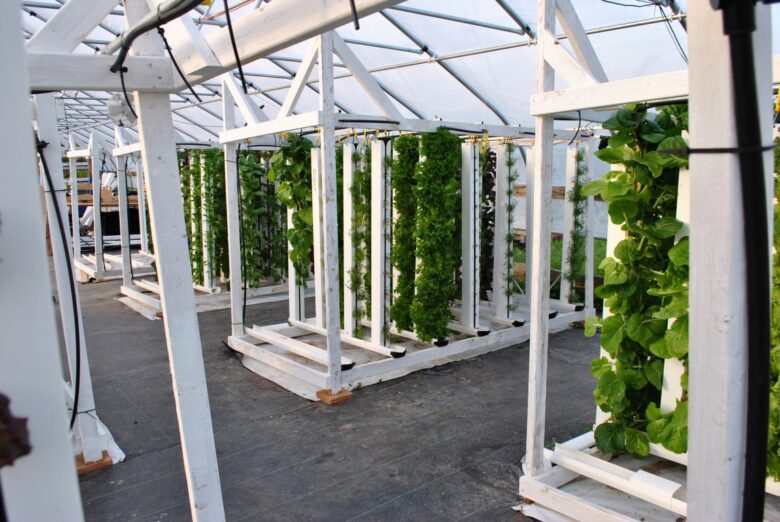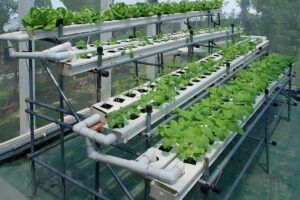In a world where space is limited and the desire for fresh, homegrown produce is ever-growing, a solution has emerged that defies traditional gardening norms and maximizes yield like never before. Enter the world of home hydroponic gardening, an innovative and fascinating approach to cultivation that places plants at the center of an aquatic wonderland. With the power to grow fresh herbs, vibrant vegetables, and even delicious fruits right in the comfort of your own home, hydroponics is revolutionizing the way we think about gardening. In this article, we will delve into the realm of home hydroponic gardening and explore the best practices that ensure a bountiful harvest, nourishing both body and mind. So, get ready to embark on an aquatic journey of horticultural bliss as we unlock the secrets to maximizing yield with home hydroponics.
Planning and Setting up Your Home Hydroponic Garden: Key Considerations
When it comes to maximizing yield with your home hydroponic garden, there are several key considerations that can make all the difference. By understanding these best practices, you can ensure your plants thrive and produce an abundant harvest. From selecting the right system to providing optimal growing conditions, here are some essential factors to keep in mind.
1. System Selection: Choosing the appropriate hydroponic system for your space and needs is crucial. Options range from simple DIY setups to more sophisticated systems such as nutrient film technique (NFT), deep water culture (DWC), or vertical towers. Consider factors such as space availability, budget, and desired crop types to determine which system will work best for you.
2. Light and Nutrient Balance: Providing adequate light and nutrients is essential for healthy plant growth. Ensure your hydroponic garden receives the right amount and type of lighting, whether it’s natural sunlight or artificial grow lights. Additionally, maintaining the optimum nutrient balance in your solution is crucial. Regularly test and adjust the nutrient levels to prevent deficiencies or excesses that can hinder plant growth and productivity.
3. Environmental Factors: Creating the ideal environment for your hydroponic garden is vital. Temperature, humidity, and airflow play a significant role in plant health and yield. Aim for a temperature range of 65-80°F (18-27°C) and maintain proper humidity levels to avoid mold or disease. Adequate airflow helps prevent stagnant air and provides plants with fresh oxygen.
Choosing the Right Grow System for Maximum Yield and Efficiency
When it comes to maximizing yield and efficiency in your home hydroponic garden, choosing the right grow system is key. With the right system in place, you can ensure your plants are getting the optimal conditions for growth, resulting in bigger and healthier yields.
One of the most popular and efficient grow systems for home hydroponic gardening is the deep water culture (DWC) system. This system involves suspending the plant’s roots in a nutrient-rich solution, allowing them to constantly absorb water and nutrients. This method provides excellent aeration to the roots, promoting rapid and vigorous growth. Plus, the simplicity of the DWC system makes it perfect for beginners.
If you’re looking for a versatile option that allows you to grow a variety of plants, the ebb and flow system might be the one for you. This system involves flooding the plant’s roots with nutrient-rich water and then draining it back into a reservoir. This cycle repeats intermittently, ensuring the roots receive the necessary oxygen between flooding. The ebb and flow system is ideal for plants that prefer periods of dryness and is also easy to set up and maintain.
- Determine your space: Consider the available space in your home or garden before selecting a grow system. Some systems may require more vertical or horizontal space, so choose accordingly.
- Consider your desired plant types: Different plants have different requirements. If you plan to grow larger plants or vegetables, consider a system that can provide ample support and space for their growth.
- Assess your time commitment: Some grow systems require more maintenance and monitoring than others. If you have limited time for gardening, opt for a system that is low-maintenance and requires less frequent attention.
By carefully selecting the right grow system for your home hydroponic garden, you can ensure maximum yield and efficiency while enjoying the benefits of growing your own fresh produce.
Optimizing Nutrient Delivery: Essential Strategies for Plant Growth
When it comes to maximizing yield in home hydroponic gardening, nutrient delivery plays a crucial role. Ensuring that plants receive the right combination of nutrients at the right time is essential for their growth and productivity. By implementing some proven strategies, you can optimize nutrient delivery and take your hydroponic garden to new heights.
1. Implement a balanced nutrient solution: A well-balanced nutrient solution is key to promoting healthy plant growth. Make sure to provide the essential macronutrients such as nitrogen, phosphorus, and potassium in the right proportions. Supplement these with important micronutrients such as iron, manganese, and zinc. Regularly monitor the pH levels of your nutrient solution to maintain an optimal range for nutrient absorption.
2. Consider foliar feeding: Sometimes, plants can benefit from foliar feeding, which involves applying nutrients directly to their leaves. This method allows for faster nutrient absorption and can be particularly useful when plants are experiencing nutrient deficiencies or when the root system is compromised. However, be mindful of the time of day you apply foliar sprays, as some nutrients are more effectively absorbed in the morning or evening.
3. Employ a timed nutrient delivery system: To ensure consistent nutrient availability for your plants, consider utilizing a timed nutrient delivery system. This system can automatically deliver a specific amount of nutrient solution at predetermined intervals, providing a steady supply of nutrients throughout the day. By implementing a timed delivery system, you can create an optimized feeding schedule that meets the unique needs of your plants.
Maintaining an Ideal Environment: Temperature, Lighting, and Humidity Control
When it comes to maximizing yield with home hydroponic gardening, creating an ideal environment is crucial. Temperature, lighting, and humidity control play a significant role in ensuring your plants thrive and produce abundantly. Here, we’ll dive into some best practices to help you maintain the perfect conditions for your hydroponic garden.
Temperature Control:
Consistent temperature is key for optimal plant growth. Aim to maintain your hydroponic garden at a temperature range of 70-75°F (21-24°C). Avoid extreme temperature fluctuations, as they can stress your plants and hinder their development. Utilize a digital thermometer to monitor the temperature in your growing area and adjust as necessary.
Lighting Control and Duration:
Providing adequate lighting is essential for successful hydroponic gardening. Opt for full-spectrum LED grow lights, as they efficiently mimic sunlight and promote healthy plant growth. Ensure your lights are positioned at the correct distance from your plants, typically 12-18 inches (30-45 cm) above the top of the canopy. To simulate natural day-night cycles, establish a consistent lighting schedule, providing about 14-16 hours of light each day during the vegetative stage, and 10-12 hours during the flowering stage.
Humidity Regulation:
Proper humidity control is vital to prevent diseases and maintain robust plant growth. Aim to keep the humidity level between 50-60% during the vegetative stage and reduce it to around 40-50% during the flowering stage. To achieve these levels, consider using a hygrometer to monitor the humidity in your growing area. Ventilation systems, dehumidifiers, or humidifiers can help regulate humidity, depending on your specific needs and climate.
Effective Pest and Disease Management Techniques for Home Hydroponic Gardens
Keeping your home hydroponic garden free from pests and diseases is essential for achieving maximum yield and sustaining healthy plant growth. Fortunately, there are several proven techniques that can help you effectively manage these challenges. By implementing these best practices, you can ensure the success of your hydroponic garden and enjoy a thriving harvest.
1. Integrated Pest Management (IPM)
- Implement a proactive approach by regularly monitoring your plants for any signs of pests or diseases.
- Introduce biological controls like beneficial insects or nematodes, which prey on common pests such as aphids or whiteflies.
- Use sticky traps to catch flying insects and minimize their population in your garden.
- Maintain a clean and tidy growing environment to prevent pests from finding suitable breeding grounds.
2. Proper Nutrient Management
- Ensure balanced nutrient solutions to promote healthy plant growth, as stressed plants are more susceptible to pests and diseases.
- Regularly test the pH and nutrient levels of your hydroponic system to adjust the nutrient solution accordingly.
- Closely follow the recommended feeding schedules for different plant stages to avoid over or underfeeding.
- Avoid overwatering, as excessive moisture can create a favorable environment for pests and diseases to thrive.
3. Quarantine and Crop Rotation
- Quarantine newly purchased plants for a period of time to ensure they are free from any potential pests or diseases.
- Practice crop rotation by changing the location of your plants to prevent the buildup of pests and diseases in the growing media.
- Consider using sterile growing media to reduce the risk of introducing unwanted organisms into your hydroponic system.
- Regularly sanitize your hydroponic equipment, such as grow trays and tools, to eliminate any potential sources of contamination.
By following these effective pest and disease management techniques, you can create an optimal growing environment for your home hydroponic garden. Remember, prevention is key, so regularly inspect your plants, maintain proper nutrient levels, and practice good hygiene to keep pests and diseases at bay. With careful attention and proactive measures, you’ll be rewarded with bountiful and healthy harvests.
In the intriguing world of home hydroponic gardening, where science meets nature, we have delved into the depths of plant cultivation to uncover the secrets behind maximizing yield. From vibrant green leafy vegetables to luscious blooming flowers, hydroponics has revolutionized the way we nurture and harvest our favorite plants.
Through this article, we have journeyed alongside passionate gardeners, exploring the intricacies of hydroponic systems and learning the best practices that contribute to bountiful yields. With an open mind and a thirst for knowledge, we have unraveled the mysteries of nutrient solutions and the art of balancing pH levels to ensure our plants thrive in their water-based haven.
By shedding light on the importance of lighting fixtures and selecting the optimal spectrum, we have witnessed firsthand how plants respond to the power of illumination. We have unraveled the true potential of LEDs that mimic the sun’s rays, guiding our plants towards unparalleled growth and maximal productivity.
Our exploration has also taken us down the path of proper plant care, highlighting the significance of pruning, training, and maintaining a vigilant eye for pests and diseases. We have concluded that a watchful gardener fosters a healthy environment, allowing plants to flourish in their hydroponic habitat.
As we bid farewell to our hydroponic journey, we encourage you, fellow gardener, to embark on your own hydroponic odyssey. Armed with newfound knowledge and an understanding of best practices, let your imagination run wild and your plants reach new heights. Delve into the realm of hydroponics with confidence and passion, for the possibilities of home cultivation are only limited by the bounds of your creativity.
May your home hydroponic garden be a testament to the wonders of sustainable and efficient plant cultivation. Let your yields be plentiful, your harvests be vibrant, and your love for plants continue to grow as you embrace the art of maximizing yield with home hydroponic gardening.



